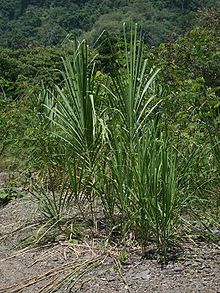| Gynerium | |
|---|---|

| |
| Scientific classification | |
| Kingdom: | Plantae |
| Clade: | Tracheophytes |
| Clade: | Angiosperms |
| Clade: | Monocots |
| Clade: | Commelinids |
| Order: | Poales |
| Family: | Poaceae |
| Clade: | PACMAD clade |
| Subfamily: | Panicoideae |
| Tribe: | Gynerieae Sánchez-Ken & L.G. Clark (2001) |
| Genus: | Gynerium Willd. ex P. Beauv. 1812 not Bonpl. 1813[1] |
| Species: | G. sagittatum
|
| Binomial name | |
| Gynerium sagittatum | |
| Synonyms[2] | |
| |
Gynerium is a monotypic genus of Neotropical plants in the grass family, native to Mexico and Colombia, Central America, South America, and the West Indies.[3][4] It is classified in its own tribe Gynerieae.[5]
The sole species in the genus is Gynerium sagittatum, a tall grass that grows up to six metres (twenty feet) high. It is a very vigorous species that grows into a considerably dense mass of vegetation. The species is known as "cana-do-rio", "cana-flecha", "cana-frecha", "ubá" and "cana-brava" in Brazil, "caña brava" in Peru and Colombia, "chuchío" in eastern Bolivia, and "tañil" in Guatemala and other Spanish speaking countries. It is known in English as "wildcane"[6] or "wild cane", while "arrow cane" is less common (sagitta is Latin for arrow).
- ^ Tropicos, search for Gynerium
- ^ Kew World Checklist of Selected Plant Families
- ^ Willdenow, Carl Ludwig von ex Palisot de Beauvois, Ambroise Marie François Joseph 1812. Essai d'une Nouvelle Agrostographie 138-139 description in Latin, commentary in French
- ^ Willdenow, Carl Ludwig von ex Palisot de Beauvois, Ambroise Marie François Joseph 1812. Essai d'une Nouvelle Agrostographie plate XXIV (24), figure VI (6 a-d) line drawings of Gynerium sagittatum; figure captions on caption page 16
- ^ Soreng, Robert J.; Peterson, Paul M.; Romschenko, Konstantin; Davidse, Gerrit; Zuloaga, Fernando O.; Judziewicz, Emmet J.; Filgueiras, Tarciso S.; Davis, Jerrold I.; Morrone, Osvaldo (2015). "A worldwide phylogenetic classification of the Poaceae (Gramineae)". Journal of Systematics and Evolution. 53 (2): 117–137. doi:10.1111/jse.12150. hdl:11336/25248. ISSN 1674-4918. S2CID 84052108.

- ^ USDA, NRCS (n.d.). "Gynerium sagittatum". The PLANTS Database (plants.usda.gov). Greensboro, North Carolina: National Plant Data Team. Retrieved 9 May 2015.